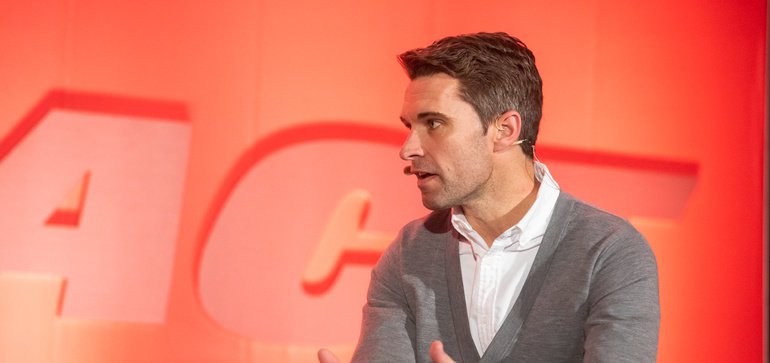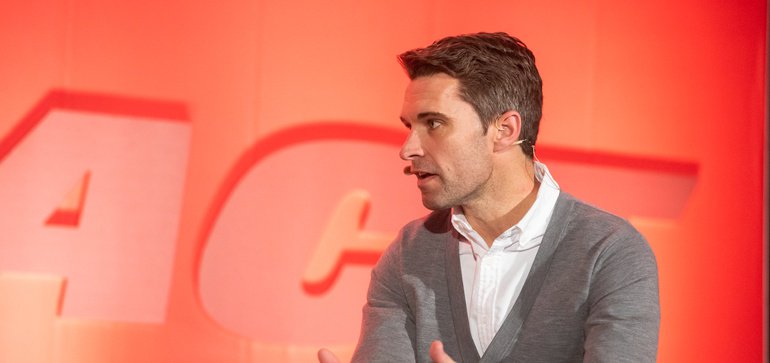
NEW YORK — Not all direct-to-consumer brands see a problem that needs fixing and jump to provide a solution. Allbirds Co-Founder and Co-CEO Tim Brown built his footwear company to solve a personal problem: shoes he felt turned him into a billboard rather than providing comfort and appealing design. As a retired professional athlete, it’s a problem Brown had to deal with more than others.
“I was sponsored by one of the big sportswear brands and I had the insight really that footwear was over-designed, over-logoed, over-colored and there was an opportunity for something simple,” he told Retail Dive in an interview. “I think the assumption is that innovation is always about adding something new — I saw an opportunity for doing less and set out to try and make a shoe with no idea how to do that.”
Brown visited his first footwear factory in 2009, but he wouldn’t launch Allbirds with Co-Founder Joey Zwillinger until 2016. When the shoe startup did come into being, it was founded on a concept of shoes made with environmentally friendly materials that were both comfortable and had a simple, clean design. The results are shoes with no logos, made from materials like wool, trees and sugarcane.
But a product with no logos also has its drawbacks, and Brown noted during a panel at NRF’s Big Show that competitors in the footwear sector have already tried to replicate the Allbirds design in their own shoes (in fact, the company sued Steve Madden for making a pair of shoes similar to its wool runners in 2017).
“I think one of the things that’s blown us away is how quickly and how fast the copycats have come,” Brown said at the panel. “I think, at last count, there’s 17 or 18 legitimate, it feels like sort of copies of what we’re doing.”
Similar to other digitally native brands, especially in the mattress category, Allbirds allows customers a 30-day try-on period to test out the shoes and — if they’re not impressed — to return them. And much like those other direct-to-consumer players, Allbirds has plans for more brick-and-mortar stores in its future, which Brown said during the panel was “a really important part of our growth plans.” The company is also exploring the effect that physical stores have on its online business in places where stores are located — whether that means a shopper sees the store and purchases the items at home or finds the website and heads to a store to check it out.
“I think people want to try on shoes … physical retail was just a no-brainer,” he said. “I think what we found is that it’s the best marketing dollars we can spend.”
That was always one of the criticisms that digitally native brands faced, but now it’s become commonplace for a brand to launch online and open physical stores after it’s established a loyal following (and raised some much-needed financing). The bigger question for many of these brands has become: What do you do when you’ve exhausted the base for one product?
For brands like Away and Casper, that’s meant broadening the assortment and becoming more of a lifestyle brand than a company associated with one product. To that end, Away partnered with Nordstrom recently on a line that not only features its popular suitcases, but also travel accessory products, setting it up to be more of a travel company than a luggage company.
Allbirds faces a similar challenge, as a brand with one core product, and while Brown didn’t discuss specifics with Retail Dive, he alluded to an expanded assortment of products in the future. Based on the brand’s current products, and its collaboration with Outdoor Voices in 2017, it’s not hard to imagine a future where Allbirds takes a step further into the athleisure space, as popular and competitive as that sector currently is.
However the brand evolves, Brown was clear at NRF’s Big Show that Amazon isn’t in the cards — at least not yet.
“I think, for us, we’re building our brand with deep connections with our customers, great customer service, a connection with our purpose and a contract effectively with our community that we’re going to try and bring sustainability into our products in a deep and meaningful way,” Brown said. “I personally don’t see Amazon as the place where you go and make those deep kind of connections. It’s a different kind of transaction, and it’s not necessarily bad, it’s just not for us.”

